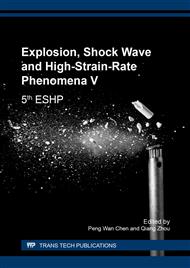p.58
p.67
p.72
p.78
p.84
p.90
p.96
p.102
p.111
A Basic Study on Shock Resistant Design for Explosion Pit
Abstract:
The mechanism of damage on the structure of an explosion pit which belongs to the Institute of Pulsed Power Science, Kumamoto University is investigated. Investigated is the mechanism of damage on the structure of an explosion pit which belongs to the Institute of Pulsed Power Science, Kumamoto University. Here, three-dimensional model with square opening (door) is used to simulate by numerical simulation. The numerical result with the actual egg-type model implies that firstly the cracks occurred at the corners of the door and grew larger. In addition, the numerically simulated results with a spherical form model are also demonstrated to study on optimizing the design of an explosion pit.
Info:
Periodical:
Pages:
84-89
Citation:
Online since:
January 2018
Price:
Сopyright:
© 2018 Trans Tech Publications Ltd. All Rights Reserved
Share:
Citation:


